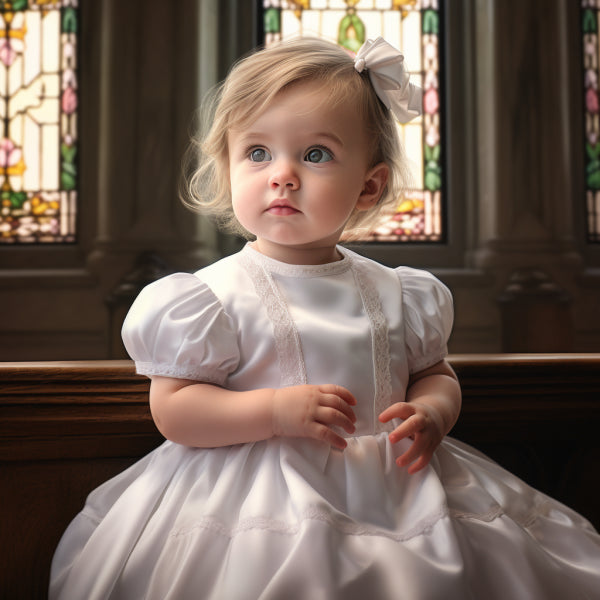Get Ready for Her Special Day: Your Ultimate Guide to Your Baby's Christening!
Posted by SOPHIA'S STYLE

Baptism is a significant milestone in many Christian families' lives. It's a sacred rite of passage, symbolizing the cleansing of original sin and the child's acceptance into the Christian community. But what does it entail, especially for baby girls?
Introduction to Baptism
Baptism, a cherished sacrament in the Christian faith, serves as a profound initiation rite that welcomes an individual into the spiritual fold of Christianity. Rooted deeply in ancient traditions, it symbolizes a person's rebirth into a life of faith, hope, and divine purpose. For many, baptism is not merely a ritual but a covenant with God, marking the beginning of a lifelong spiritual journey.
Furthermore, Christening serves as a communal event, where family, friends, and the church congregation come together to witness and celebrate this spiritual milestone. It's a moment of joy, commitment, and affirmation of faith, where the community pledges to support and guide the baptized individual in their walk with God.
In essence, Christening is a beautiful blend of divine grace, community support, and personal commitment, setting the foundation for a life enriched with spiritual growth, love, and purpose.
History and Significance
Historically, baptism traces its roots back to the times of Jesus Christ. It's seen as a sacrament, a visible sign of God's grace. For babies, it signifies purity, innocence, and a fresh start in the eyes of God. Over the centuries, the rite of baptism evolved, incorporating various traditions, symbols, and rituals. However, its core essence remained unchanged – a sacramental act of initiation, purification, and commitment to the Christian faith. The early Christian Church viewed baptism as a transformative experience, a passage from the old life of sin to a new life in Christ.
The Importance of Christening
Baptism stands as a pivotal sacrament in Christianity, marking an individual's formal entry into the community of believers. It's a public declaration of one's faith, showcasing their commitment to following the teachings of Christ and embracing the Christian way of life. Beyond its spiritual implications, baptism also serves as a rite of passage, a moment of celebration where families and communities come together to welcome the newly baptized into their fold.
Moreover, Christening acts as a bridge, connecting the spiritual and the physical realms. Through this sacrament, the heavens rejoice as another soul is claimed for Christ, and the earthly community strengthens its bond, united in faith and purpose. The act of baptism, therefore, is not just a personal journey but a communal experience, reflecting the interconnectedness of all believers in the vast tapestry of the Christian faith.
Preparing for the Christening
Like any significant event, preparation is key. It's a time of reflection, planning, and ensuring that every detail aligns with the spiritual significance and personal values associated with the ceremony. Families often spend weeks, if not months, choosing the right church, coordinating with clergy, and gathering loved ones to be a part of this momentous occasion. The preparations, both logistical and spiritual, set the tone for the day, ensuring that the baptism becomes a cherished memory for years to come.
Choosing the Right Date
The date can be a personal choice or based on religious calendars. Some families prefer dates with personal significance, like anniversaries or birthdays. Additionally, many churches have specific days dedicated to baptisms, aligning with liturgical events or church calendars. It's also essential to consider the availability of close family and friends, ensuring that those who hold a special place in the child's life can be present to witness and celebrate the occasion.
Selecting the Christening Outfit
The baptismal outfit holds profound significance, symbolizing the child's new life in Christ and their entry into the Christian community. It's not just about aesthetics; it's a reflection of tradition, faith, and the sacredness of the occasion.
For baby girls, the Christening gown often leans towards delicate fabrics like lace, satin, or silk, adorned with intricate details such as embroidery, ribbons, or pearls. The color white dominates, representing purity, innocence, and grace.
For baby boys, the outfit can range from a traditional long white gown, similar to the girls, to more modern options like a white romper or a suit. The classic gown, often made of soft materials like cotton or linen, might feature subtle embroidery or cross motifs. On the other hand, a white suit or vestment, paired with a matching hat or bonnet, offers a contemporary yet reverent look. Some families might also incorporate accessories like bow ties, suspenders, or even a family crest to add a personal touch.

Regardless of the style chosen, comfort is paramount. It's essential to ensure that the fabric is soft against the baby's skin and that the outfit is suitable for the season, ensuring the child remains comfortable throughout the ceremony. Ultimately, the baptismal outfit should resonate with the family's values, traditions, and the solemnity of the occasion, making the day memorable for everyone involved.
Traditional vs. Modern Outfits
The choice between traditional and modern Christening outfits often reflects a family's heritage, personal style, and the values they wish to emphasize during the ceremony.
Traditional outfits are reminiscent of a bygone era, often characterized by their length, reaching well below the baby's feet. Made from luxurious fabrics like silk, satin, or lace, these gowns often feature intricate hand-embroidery, delicate lace trims, and sometimes even pearls or tiny crystals. They are usually in pristine white, symbolizing purity and innocence. Many families treasure these gowns as heirlooms, passing them down through generations, each Christening adding another layer of history and sentiment to the fabric.
On the other hand, modern outfits offer a fresh take on the baptismal attire. While they maintain the sanctity of the occasion, they often incorporate contemporary designs, shorter lengths, and sometimes even a splash of subtle color. Made from a variety of materials, including organic cotton or modern blends, these gowns prioritize comfort alongside style. Some might feature unique patterns, playful motifs, or even customizable elements that allow parents to add a personal touch, such as the child's initials or birthdate.
Whether a family leans towards the timeless elegance of traditional gowns or the chic appeal of modern designs, the key lies in choosing a piece that resonates with their beliefs, honors the solemnity of the occasion, and cherishes the child's comfort and well-being.
Types of Christening Outfits
Christening outfits, steeped in tradition and symbolism, come in various styles and designs to suit diverse preferences, cultural backgrounds, and religious practices. Here's a closer look at the different types of baptismal attire available:
Classic Gowns: These are long, flowing dresses, usually in white, that have been the traditional choice for centuries. Made from materials like silk, satin, or lace, they often feature intricate embroidery, ruffles, or lace trims. Suitable for both boys and girls, these gowns are timeless and often become family heirlooms.
Romper Suits: For those seeking a more contemporary look for their baby boys, romper suits are an excellent choice. These one-piece outfits are typically made of cotton or linen and come in both short and long-sleeved versions. They might have subtle religious motifs, such as crosses, embroidered onto them.
Baptismal Suits: These are formal suits for baby boys, consisting of trousers, a shirt, a vest, and sometimes a jacket. Paired with a matching tie or bowtie, these suits offer a sharp, elegant look.
Modern Dresses: For baby girls, modern baptism dresses might be shorter than traditional gowns and incorporate contemporary design elements. They can have layers, tulle skirts, or even subtle color accents, offering a blend of tradition and modernity.
Ethnic and Cultural Attires: In many cultures, baptismal wear is deeply rooted in tradition. For instance, in some Greek Orthodox ceremonies, the child might wear a white robe or 'sticharion' symbolizing purity. Similarly, in certain African or Hispanic traditions, the attire might be adorned with specific cultural motifs or patterns.
Unisex Outfits: With a move towards more gender-neutral options, many parents opt for unisex baptismal outfits. These can be simple white robes, tunics, or even modern jumpsuits, suitable for both boys and girls.
Accessories: Beyond the primary outfit, baptism attire can also include various accessories. Bonnets or hats are common, often matching the primary material of the gown or suit. Additionally, white booties, socks, bibs with religious motifs, or even special baptismal shawls might be added to complete the look.
When selecting a Christening outfit, it's essential to consider not only the aesthetic and symbolic aspects but also practical factors like the weather, the baby's comfort, and the duration of the ceremony. Regardless of the style chosen, the outfit should reflect the sacredness of the occasion and the joy of welcoming a new soul into the Christian community.
The Christening Rituals
The baptismal rituals are a series of symbolic actions and prayers that encapsulate the essence of Christian initiation. These ceremonies, rich in symbolism, convey the profound transformation and rebirth of the individual into the Christian community. From the anointing with sacred oils, symbolizing protection and dedication to Christ, to the lighting of the baptismal candle, representing the light of Christ illuminating the newly baptized's path, each ritual holds deep spiritual significance. Through these rites, the church community and the heavens unite in celebrating the individual's new journey of faith and commitment.
The Significance of Water

In the context of baptism, water stands as a powerful symbol of cleansing and rebirth. Its purifying nature represents the washing away of original sin, while the act of immersion or pouring signifies the individual's emergence into a renewed life of faith and commitment to Christ.
The Anointing of the Oil
The anointing of the oil during baptism symbolizes the sealing of the Holy Spirit and the bestowed gifts of grace upon the baptized individual. This sacred act also serves as a protective mark, signifying the person's consecration and strengthened bond with Christ, preparing them for a life of Christian discipleship.
Celebrating the Christening
The celebration following a baptism is a joyous occasion, marking the individual's formal welcome into the Christian community. Families and friends come together, sharing in the happiness and spiritual significance of the day. This gathering often includes a festive meal, heartfelt speeches, and the exchange of gifts, all in honor of the newly baptized. It's a time of unity, gratitude, and reflection, where the community rejoices in the faith and promise of the future that lies ahead for the baptized individual.
Organizing the Reception
Organizing the reception after a baptism is an opportunity to extend the joy and sanctity of the ceremony into a communal celebration. It involves careful planning, from selecting a suitable venue to curating a menu that caters to the guests, ensuring that the ambiance reflects the spiritual significance of the day. The reception becomes a space for loved ones to come together, share stories, blessings, and hopes for the newly baptized individual's spiritual journey ahead.
Christening Gifts and Keepsakes
Baptismal gifts and keepsakes are cherished tokens that commemorate the sacredness of the baptismal day. Often imbued with spiritual significance, these gifts, ranging from personalized Bibles to cross pendants, serve as lifelong reminders of faith and the community's love and support. As the years pass, these keepsakes gain sentimental value, often becoming treasured heirlooms passed down through generations, preserving memories of that special day.
Conclusion
Christening stands as a profound milestone in the Christian journey, symbolizing faith, rebirth, and a deep connection with the divine. From the meticulous preparations to the heartfelt celebrations, every aspect of this sacrament reflects the community's commitment to nurturing and guiding the newly baptized individual. As families come together, cherishing traditions and creating new memories, baptism becomes a testament to the enduring power of faith, love, and community.

